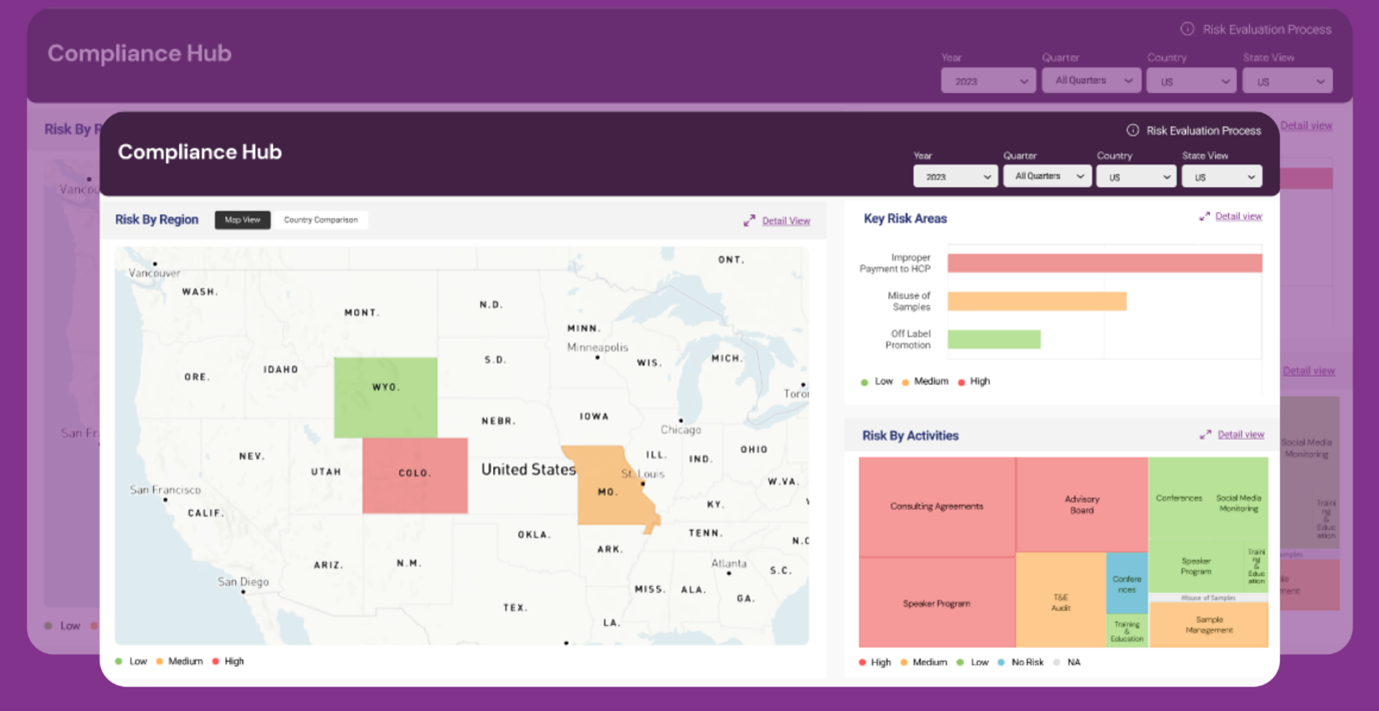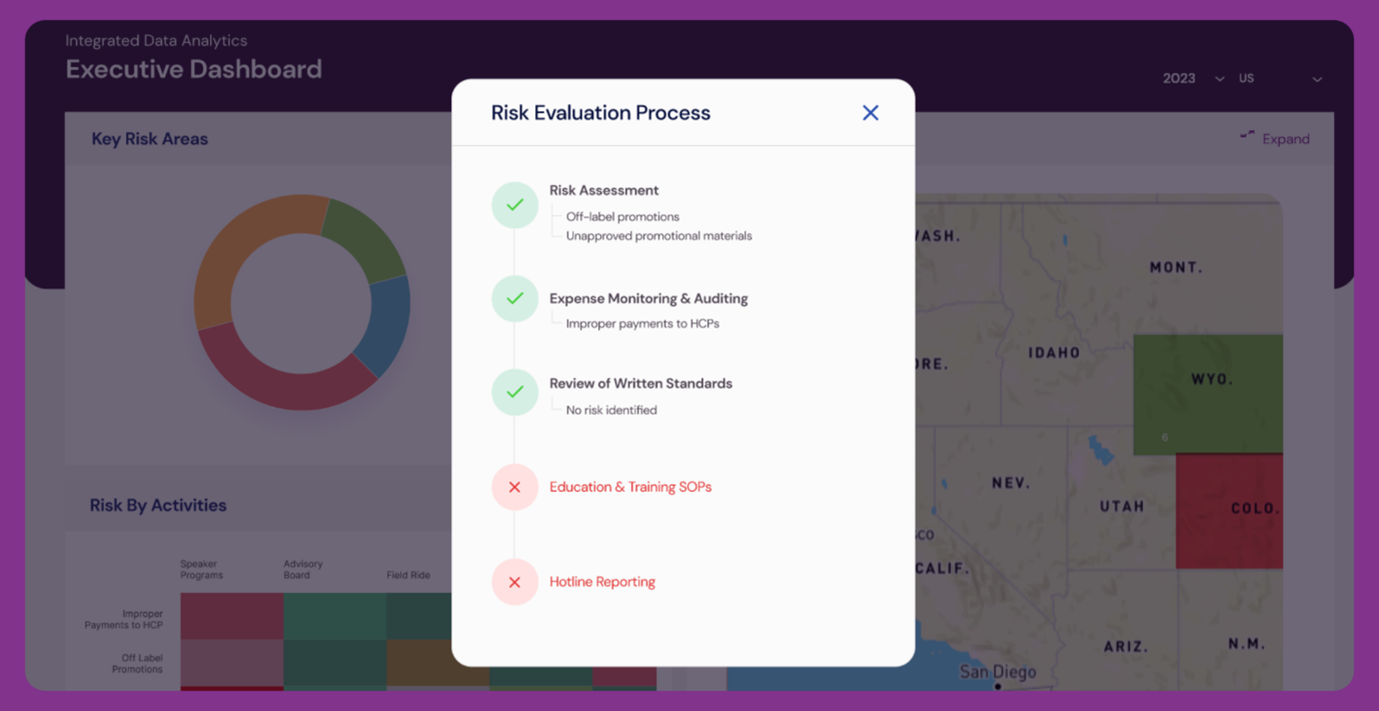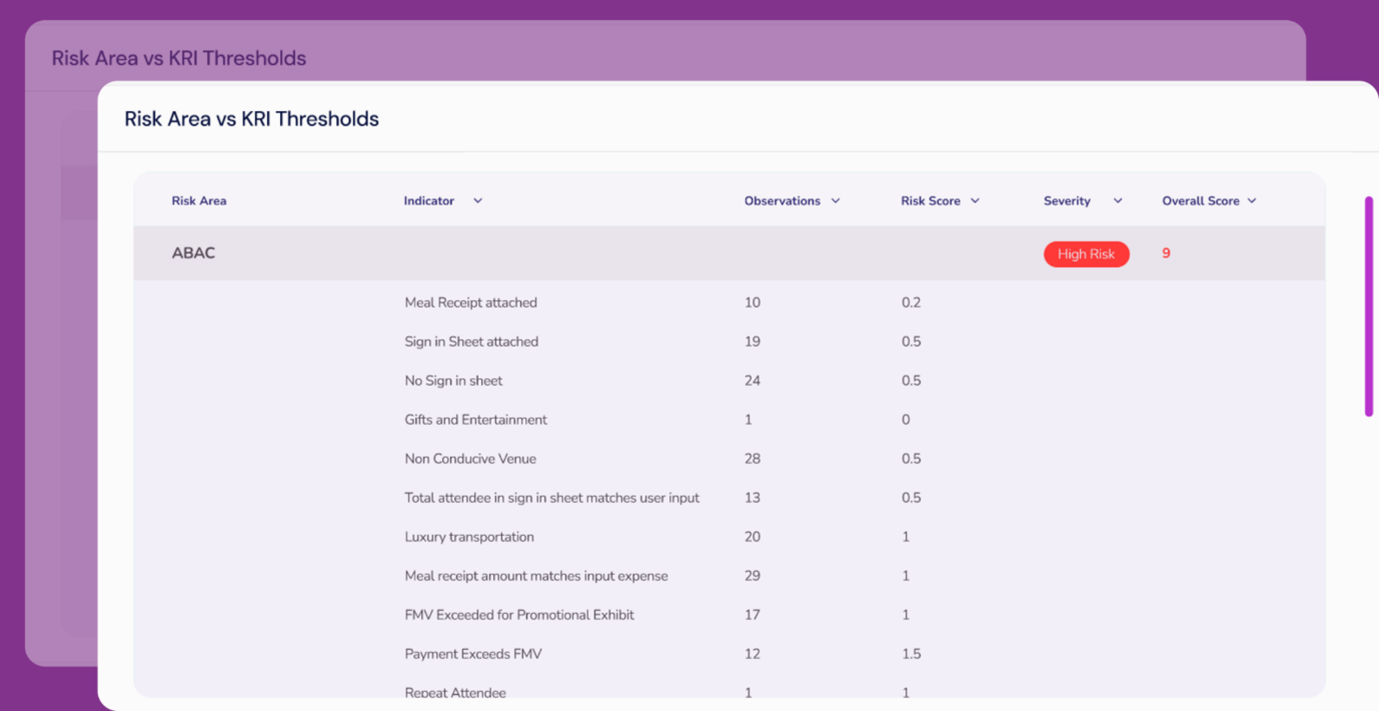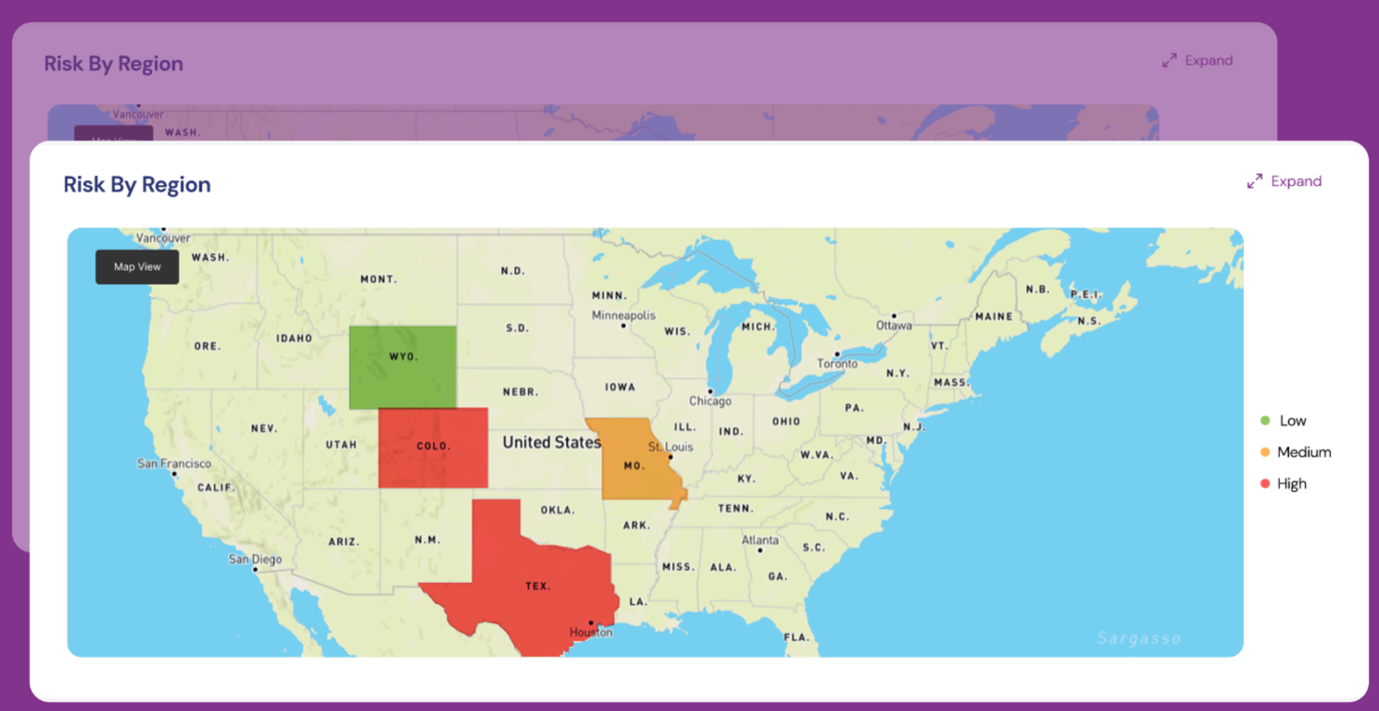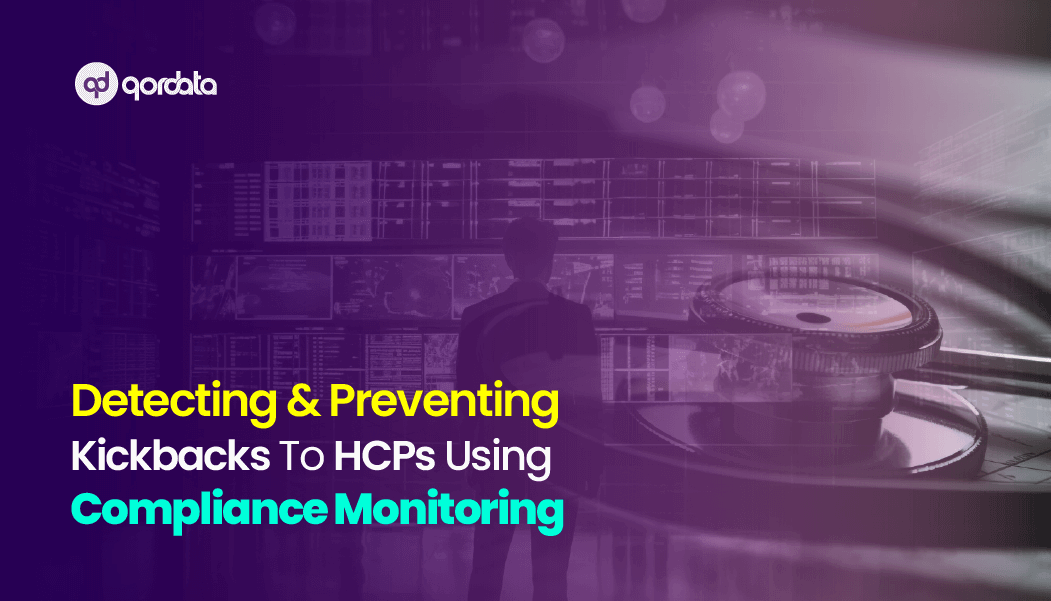As the pharmaceutical industry evolves in 2025, leveraging Pharma Data Analytics has become imperative for achieving compliance, operational efficiency, and market competitiveness.
With increasing regulatory scrutiny and the growing complexity of global markets, advanced analytics for pharma offers tools and insights to navigate challenges and seize opportunities.
This blog explores the transformative role of Pharmaceutical Analytics, its benefits, applications in different components of compliance framework, and best practices for making your compliance program effective and efficient.
What is Pharma Data Analytics?
Data Analytics refers to the application of data-driven techniques, including AI and machine learning in pharma, to process, analyze, and derive actionable insights from the vast amounts of data generated in the pharmaceutical sector.
From HCP engagement to compliance monitoring of commercial activities and T&E expense auditing, analytics empower organizations to:
- Detect trends and patterns.
- Identify and mitigate compliance risks proactively.
- Optimize processes and decision-making.
Pharma Data Solutions provides a competitive edge in a data-intensive landscape by turning raw data into actionable intelligence.
Challenges in Pharmaceutical Data Analytics
While the potential of pharma data solutions is immense, companies often face these challenges:
- Data Silos: Fragmented data sources hinder comprehensive analysis. Information is often scattered across multiple platforms, such as reporting systems, HCP engagement records, and auditing tools. This lack of integration limits visibility and creates barriers to effective data analysis.
- Compliance Risks: Compliance teams must adapt to evolving laws, including the Anti-Kickback Statute (AKS) and the Foreign Corrupt Practices Act (FCPA), and Sunshine Act Reporting requirements among others.
- Expense Fraud Detection: Identifying fraudulent activities or misconduct requires advanced analytics and proactive risk monitoring to uncover hidden patterns.
- Varied Risk Categories: Companies face diverse risks, from improper HCP payments and sample misuse to off-label promotions and compliance concerns in consulting agreements or speaker programs.
Overcoming these obstacles requires investing in robust pharma analytics software and fostering a culture of data-driven decision-making.
Key Features of Pharma Analytics Software
Enterprise Risk Analytics Solution enables compliance teams to gain comprehensive visibility into compliance risks and leverage predictive analytics to elevate a compliance program’s effectiveness and efficiency.
- Access high-level executive analyses with drill-down capabilities for in-depth insights.
- Monitor organization-wide risk areas, including activities like “Improper payments to HCPs” and “Off-label promotions,” across all commercial operations.
- Delve into the specifics of various commercial activities, such as speaker programs, in-office meals, advisory boards, and more.
- Seamlessly integrate enterprise data from reporting systems, hotlines, auditing and monitoring platforms, HCP engagements, and other sources for comprehensive analysis.
- Utilize AI-driven configurations for calculating risks, supporting data-driven strategic decisions.
- Apply predictive analytics to forecast trends and identify potential risks before they escalate.
Benefits of Pharma Data Analytics in Compliance
Derive maximum value from data analytics in pharma with:
Enterprise Risk Areas and At-Risk Activities:
Risk Assessment Across Enterprise Functions:
Periodic Trend Analysis of Commercial Activities:
Global and Local View of Risks:
Best Practices for Pharma Analytics
- Enhance HCP Engagement Management
With regulations like the Sunshine Act and the Anti-Kickback Statute (AKS), pharmaceutical companies are under increasing scrutiny to ensure ethical HCP interactions. Pharma Data Analytics facilitates:
- FMV Determination: Advanced analytics provide benchmarks and predictive models to determine FMV for HCP engagements, ensuring payments remain within regulatory guidelines.
- Background and Eligibility Checks: Analytics tools can automate HCP background checks, flagging potential compliance risks such as debarred or ineligible professionals.
- Expense Monitoring and Auditing: By integrating pharma analytics software, companies can track HCP expenses, identify anomalies, and conduct 100% audits on expense reports.
- Streamline Aggregate Spend Reporting
Compliance with aggregate spend reporting requirements is complex and data-intensive. Pharmaceutical Data Analytics streamlines this process by:
- Consolidating data across departments and geographies.
- Identifying discrepancies in spend records.
- Maintain audit readiness
- Compliance in Commercial Activities
Speaker programs, lunch-and-learns, and ride-alongs are common pharmaceutical marketing activities but come with compliance risks. Pharma Data Analytics ensures:
- Comprehensive monitoring of program expenditures.
- Adherence to transparency requirements.
- Early detection of suspicious patterns, such as excessive spending or improper gifts.
- Mitigate Fraud and Abuse Risks
Fraudulent activities in expense reporting or HCP engagements can lead to significant penalties. Predictive analytics in pharma can identify red flags, such as:
- Unusual expense patterns
- Luxury transportation misuse
- Suspicious keywords in documentation
- Risk-Based Monitoring
- Prioritize high-risk activities or regions for detailed audits and reviews.
- Allocate resources effectively by analyzing historical trends and predictive models.
Emerging Trends in Pharma Data Analytics
As we approach 2025, several emerging trends are reshaping the landscape of Pharma Data Analytics. These advancements are empowering pharmaceutical companies to address compliance challenges with greater precision and agility:
- Real-Time Compliance Monitoring
- Enhanced Data Visualization
- AI-Powered Predictive Analytics
- Blockchain for Transparency
- Cloud-based solution for remote access and cross-functional collaboration
Conclusion
Pharmaceutical companies must adopt robust data analytics and embrace data-driven decision-making to navigate compliance risks effectively. Leveraging real-time monitoring, artificial intelligence and data integration can enhance compliance management. As data continues to drive innovation, the role of pharma data solutions in HCP engagement and commercial compliance will only grow, making it a pivotal investment for forward-thinking organizations.

